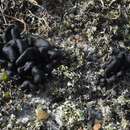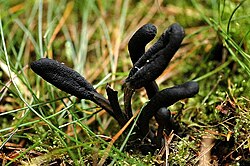en
names in breadcrumbs


Geoglossaceae és una família de fongs dins la classe Geoglossomycetes. Anteriorment s'havien definit 6 gèneres i 48 espècies[1] però la filogenètica molecular que d'aquests gèneres els que tenien espores acolorides pertanyien als Leotiomycetes. La resta de gèneres amb espores negres s'ubiquen actualment a la nova classe (Geoglossomycetes) i ordre (Geoglossales).[2] Aquests fongs viuen el sòl o sobre vegetació podrint-se.[3] Normalment són fongs petits i de color negre amb una alçada de 2–8 cm. Cal un microscopi per identificar-los.[4]
Els Geoglossaceae abunden en lloc herbosos, en arbredes de coníferes, de planifolis i en arbredes mixtes.[3][5]
Geoglossaceae és una família de fongs dins la classe Geoglossomycetes. Anteriorment s'havien definit 6 gèneres i 48 espècies però la filogenètica molecular que d'aquests gèneres els que tenien espores acolorides pertanyien als Leotiomycetes. La resta de gèneres amb espores negres s'ubiquen actualment a la nova classe (Geoglossomycetes) i ordre (Geoglossales). Aquests fongs viuen el sòl o sobre vegetació podrint-se. Normalment són fongs petits i de color negre amb una alçada de 2–8 cm. Cal un microscopi per identificar-los.
Die Familie der Erdzungenverwandten (Geoglossaceae) stellt nach derzeitigem Forschungsstand die einzige Familie der Ordnung der Erdzungenartigen (Geoglossales) innerhalb der einzigen Klasse der Geoglossomycetes dar.[1]
Erdzungenverwandte bilden meist kleine, schwarze und keulenförmige Pilze, die 2–8 cm groß werden. Das Hymenium ist schwarz und hebt sich besonders im Jugendstadium nicht deutlich vom Stiel ab. Erdzungen gleichen vom Habitus her Kernkeulen, die aber kein Hymenium besitzen, sondern im Gegensatz zu den Erdzungen durch ihre Perithecien punktiert sind.
Ihre Asci sind inoperculat. Zur genauen Bestimmung ist ein Lichtmikroskop unerlässlich.[2] Neuerdings werden nur noch Arten mit dunklen Sporen zu den Erdzungenverwandten gezählt.
Erdzungenverwandte leben saprobiontisch auf dem Boden oder totem organischem Material.[3] Sie haben eine weltweite Verbreitung vor allem in moosiger und sumpfiger Umgebung[1].
Ursprünglich von Corda beschrieben, wechselte die Familie lange die systematische Stellung und beinhaltete 6 Gattungen mit 48 Arten.[4] Molekularbiologische Untersuchungen zeigten, dass Arten mit hellen oder gefärbten Sporen zu den Leotiomycetes gehören. Die verbliebenen Gattungen mit dunklen Sporen hingegen sind systematisch isoliert und bilden nun eine eigene Ordnung und Klasse. 2013 wurde eine neue Gattung Glutinoglossum von Geoglossum abgetrennt und die Gattung Sabuloglossum neu beschrieben.[5] 2015 wurde schließlich die Gattung Maasoglossum als basale Gattung der Erdzungenverwandten erkannt. Daher zählen im Moment 9 Gattungen zu den Erdzungenverwandten:[6][7]
Die Gattungen Stielzungen (Microglossum), Spatelinge (Spathularia) und Blasssporerdzungen (Thuemenidium) werden nun in verschiedenen Ordnungen der Leotiomycetes eingegliedert.
Die Familie der Erdzungenverwandten (Geoglossaceae) stellt nach derzeitigem Forschungsstand die einzige Familie der Ordnung der Erdzungenartigen (Geoglossales) innerhalb der einzigen Klasse der Geoglossomycetes dar.
Geoglossaceae is a family of fungi in the order Geoglossales, class Geoglossomycetes. These fungi are broadly known as earth tongues. The ascocarps of most species in the family Geoglossaceae are terrestrial and are generally small, dark in color, and club-shaped with a height of 2–8 cm. The ascospores are typically light-brown to dark-brown and are often multiseptate. Other species of fungi have been known to parasitize ascocarps.[1][2] The use of a compound microscope is needed for accurate identification.[3]
Geoglossum cookeanum, G. glabrum
Trichoglossum (T. hirsutum, T. octopartitum
Cladogram showing phylogeny of Geoglossomycetes based on a four-gene dataset.[4]The fungi that are now included in the fungal class Geoglossomycetes were previously considered by mycologists to be a family (Geoglossaceae) within the class Leotiomycetes. The family Geoglossaceae sensu lato was previously defined with 6 genera and 48 species.[5] Early molecular evidence using ribosomal DNA[6][7][8] suggested that Geoglossaceae sensu lato was not a monophyletic group, and that the hyaline spored genera (e.g. Leotia, Microglossum, and Spathularia) were not allied within the same clade as the darker-spored genera (Geoglossum and Trichoglossum). Schoch et al.,[9] using a six-gene phylogeny including ribosomal DNA and protein-coding genes, found support for the establishment of a new class (Geoglossomycetes), containing the genera Geoglossum, Sarcoleotia, and Trichoglossum. Further molecular research resulted in the addition of Nothomitra (previously treated as a relative or synonym of Microglossum) to the group in 2011.[10] Glutinoglossum was circumscribed in 2013 to contain the species formerly known as Geoglossum glutinosum, and a new European species, G. heptaseptatum.[4]
Several species in the genus Neolecta have similar morphology and are also known by the common name of "earth tongues", but they are members of the quite distantly related Taphrinomycotina, an entirely different subdivision of the Ascomycota.
Earth tongues are commonly found in soil or among rotting vegetation.[11] In North America, they are commonly found in coniferous woodland, broad-leaved woodland and mixed woodland habitats,[12] whereas in Europe they are commonly found in grassland habitats[11][13] and are major components of the endangered waxcap grassland habitat.
Geoglossaceae is a family of fungi in the order Geoglossales, class Geoglossomycetes. These fungi are broadly known as earth tongues. The ascocarps of most species in the family Geoglossaceae are terrestrial and are generally small, dark in color, and club-shaped with a height of 2–8 cm. The ascospores are typically light-brown to dark-brown and are often multiseptate. Other species of fungi have been known to parasitize ascocarps. The use of a compound microscope is needed for accurate identification.
Geoglossomycetes es una clase de hongos ascomicetos que contiene un orden Geoglossales, una familia Geoglossaceae y alrededor de ocho géneros. Estos hongos son ampliamente conocidos como lenguas terrestres. Los ascocarpos de la mayoría de las especies de la clase Geoglossomycetes son terrestres y generalmente pequeños, de color oscuro y en forma de maza con una altura de 2 a 8 cm. Las ascosporas son típicamente de color marrón claro a marrón oscuro y a menudo son multiseptadas. Se necesita el uso de un microscopio compuesto para una identificación precisa.[1]
Las lenguas terrestres se encuentran comúnmente en el suelo o entre la vegetación como descomponedores de materia orgánica. En el continente americano se encuentran comúnmente en bosques coníferos, bosques de hoja ancha y hábitats de bosques mixtos, mientras que en Europa se encuentran comúnmente en hábitats de pastizales y son componentes principales de las especies en peligro de extinción en hábitat de pastizales en cera.[2][3]
Los hongos que ahora están incluidos en la clase de hongos Geoglossomycetes fueron considerados previamente por los micólogos como una familia (Geoglossaceae) dentro de la clase Leotiomycetes.[4] La familia Geoglossaceae sensu lato se definió previamente con 6 géneros y 48 especies. La evidencia molecular temprana utilizando ADN ribosómico sugirió que Geoglossaceae sensu lato no era un grupo monofilético y que los géneros de esporas hialinas (por ejemplo, Leotia, Microglossum y Spathularia) no estaban emparentados dentro del mismo clado como los géneros de esporas más oscuras (Geoglossum y Trichoglossum). Schoch et al. utilizando una filogenia de seis genes que incluye ADN ribosómico y genes que codifican proteínas, encontraron un apoyo para el establecimiento de una nueva clase (Geoglossomycetes), que contiene los géneros Geoglossum, Sarcoleotia y Trichoglossum. La investigación molecular adicional resultó en la adición de Nothomitra al grupo en 2011, previamente tratado como un pariente de Microglossum).[5] [6]Glutinoglossum fue circunscrito en 2013 para contener la especie anteriormente conocida como Geoglossum glutinosum y una nueva especie europea, G. heptaseptatum.[7]
Incluye los siguientes géneros:
Una posible filogenia con algunas especies y géneros es la siguiente:[8]
Geoglossum cookeanum, G. glabrum
Trichoglossum (T. hirsutum, T. octopartitum)
Geoglossomycetes es una clase de hongos ascomicetos que contiene un orden Geoglossales, una familia Geoglossaceae y alrededor de ocho géneros. Estos hongos son ampliamente conocidos como lenguas terrestres. Los ascocarpos de la mayoría de las especies de la clase Geoglossomycetes son terrestres y generalmente pequeños, de color oscuro y en forma de maza con una altura de 2 a 8 cm. Las ascosporas son típicamente de color marrón claro a marrón oscuro y a menudo son multiseptadas. Se necesita el uso de un microscopio compuesto para una identificación precisa.
Les Geoglossaceae sont une famille de champignons ascomycètes, uniques représentants de l'ordre des Geoglossales et de la classe des Geoglossomycetes.
Selon BioLib (19 mai 2020)[1] :
Les Geoglossaceae sont une famille de champignons ascomycètes, uniques représentants de l'ordre des Geoglossales et de la classe des Geoglossomycetes.
Geoglossaceae is een familie van schimmels van de klasse Leotiomycetes, behorend tot de orde van Helotiales.
De familie Geoglossaceae bestaat uit de volgende geslachten:
Geoglossaceae is een familie van schimmels van de klasse Leotiomycetes, behorend tot de orde van Helotiales.
Geoglossaceae é uma família de fungos no filo Ascomycota. Era anteriormente definida por 6 géneros e 48 espécies.[1] As sequências de ADN mostraram que os géneros com esporos claros ou coloridos e estruturas sexuais pertencem em Leotiomycetes. Os restantes géneros com esporos escuros e estruturas sexuais são parentes distantes e passaram a ser incluídos numa nova classe Geoglossomycetes e ordem Geoglossales.[2] Estes fungos vivem no solo ou entre vegetação em decomposição.[3] São geralmente pequenos, pretos, e em forma de bastão com altura de 2–8 cm. Podem por vezes ser encontrados cobertos com esporos brancos. É necessário um microscópio para identificá-los.[4]
|isbn= (ajuda) Geoglossaceae é uma família de fungos no filo Ascomycota. Era anteriormente definida por 6 géneros e 48 espécies. As sequências de ADN mostraram que os géneros com esporos claros ou coloridos e estruturas sexuais pertencem em Leotiomycetes. Os restantes géneros com esporos escuros e estruturas sexuais são parentes distantes e passaram a ser incluídos numa nova classe Geoglossomycetes e ordem Geoglossales. Estes fungos vivem no solo ou entre vegetação em decomposição. São geralmente pequenos, pretos, e em forma de bastão com altura de 2–8 cm. Podem por vezes ser encontrados cobertos com esporos brancos. É necessário um microscópio para identificá-los.
Geoglossaceae Corda, 1838
Типовой родГеогло́ссовые (лат. Geoglossaceae) — семейство аскомицетовых грибов, выделенное в монотипные порядок Geoglossales Zheng Wang, C.L. Schoch & Spatafora и класс Geoglossomycetes Zheng Wang, C.L. Schoch & Spatafora.
Грибы небольших размеров, в высоту могут вырастать от 2 до 8 см, имеют в основном чёрную окраску[1].
Живут в почве или среди подгнивающей растительности[2]. Иногда они бывают покрыты спорами.
Геогло́ссовые (лат. Geoglossaceae) — семейство аскомицетовых грибов, выделенное в монотипные порядок Geoglossales Zheng Wang, C.L. Schoch & Spatafora и класс Geoglossomycetes Zheng Wang, C.L. Schoch & Spatafora.
地舌菌綱(學名:Geoglossomycetes)是子囊菌門盤菌亞門的一個綱,為一個單型的分類元,其下只有地舌菌目(Geoglossales)一個單型目,而地舌菌目亦只有地舌菌科(Geoglossaceae)一個科。地舌菌科的真菌子實果(英语:Ascocarp)多為陸生、小型、深色且呈棍形,高約2-8公分,有被其他種真菌寄生的紀錄[1][2]。子囊孢子多為淺棕色至深棕色,並具有多個隔板(英语:septa)。其下物種的精準鑑別可能需仰賴顯微鏡[3]。
地舌菌綱的真菌過去被視為錘舌菌綱下的一個科(地舌菌科),並包含6個屬,共48個物種[4]。不過rDNA的序列分析顯示過去較廣義的地舌菌科並非單系群,錘舌菌屬(英语:Leotia)、小舌菌屬與地匙菌屬(英语:Spathularia)等子囊孢子為透明的類群,與地舌菌屬和毛舌菌屬等子囊孢子為深色的類群形成了兩個不同的演化支[5][6][7]。2009年,Schoch等人以六個基因的序列分析子囊菌門中各類群的親緣關係,結果主張將地舌菌科提升至綱的地位,其下包含地舌菌屬、毛舌菌屬與肉锤菌属(英语:sarcoleotia)[8]。2011年另一項研究進一步將原本地位未定的假地杖菌属(英语:Nothomitra)也歸入地舌菌綱[9]。2013年,地舌菌綱下又設計了新屬Glutinoglossum,包含粘地舌菌(英语:Glutinoglossum glutinosum)與一新物種Glutinoglossum heptaseptatum(英语:Glutinoglossum heptaseptatum),並新增一個單型屬Sabuloglossum(英语:Sabuloglossum),其下包含原屬Thuemenidium(英语:Thuemenidium)的物種Sabuloglossum arenarium[10]。2014年,有研究將地舌菌屬的四個物種獨立成新屬Hemileucoglossum(英语:Hemileucoglossum)(仍屬地舌菌科)[11],同年另一屬Leucoglossum(英语:Leucoglossum)亦被歸入地舌菌科中[12]。
下列演化樹說明了地舌菌綱中各物種的親緣關係[10][註 1]。
库克地舌菌(英语:Geoglossum cookeanum)、平滑地舌菌(英语:Geoglossum glabrum)
荫蔽地舌菌(英语:Geoglossum umbratile)
毛舌菌屬(毛舌菌、八段毛舌菌(英语:Trichoglossum octopartitum))
粘地舌菌(英语:Glutinoglossum glutinosum)
地舌菌綱的真菌生長在土壤或腐爛的植物中[13],在北美洲普遍分布於針葉林、闊葉林與混合林[14],在歐洲則普遍分布於草原[13][15],是蠟傘草原(英语:Waxcap grassland)中的重要物種。
|date=中的日期值 (帮助) |date=中的日期值 (帮助) 地舌菌綱(學名:Geoglossomycetes)是子囊菌門盤菌亞門的一個綱,為一個單型的分類元,其下只有地舌菌目(Geoglossales)一個單型目,而地舌菌目亦只有地舌菌科(Geoglossaceae)一個科。地舌菌科的真菌子實果(英语:Ascocarp)多為陸生、小型、深色且呈棍形,高約2-8公分,有被其他種真菌寄生的紀錄。子囊孢子多為淺棕色至深棕色,並具有多個隔板(英语:septa)。其下物種的精準鑑別可能需仰賴顯微鏡。

テングノメシガイ綱と(Geoglossomycetes)は、子嚢菌門チャワンタケ亜門の綱の一つ。古くはテングノメシガイ科(Geoglossaceae)として6属48種で定義され[1]、ビョウタケ目に属していた。DNA配列の分析により、ズキンタケ綱に配置換えされたもの、新しくテングノメシガイ綱とテングノメシガイ目に配置されたものがある[2]。
テングノメシガイ綱と(Geoglossomycetes)は、子嚢菌門チャワンタケ亜門の綱の一つ。古くはテングノメシガイ科(Geoglossaceae)として6属48種で定義され、ビョウタケ目に属していた。DNA配列の分析により、ズキンタケ綱に配置換えされたもの、新しくテングノメシガイ綱とテングノメシガイ目に配置されたものがある。
콩나물고무버섯과(Geoglossaceae)는 자낭균류 과의 하나이다. 콩나물고무버섯강(Geoglossomycetes)의 유일한 과이다. 이전에는 6속 48종으로 정의했다.[1].
분자생물학적 분석을 통해, 밝거나 색이 있는 포자를 지닌 속은 두건버섯강으로 분류한다. 나머지의 포자가 어두운 색을 띠는 속은 이 과에 속하며, 현재 콩나물고무버섯강과 콩나물고무버섯목으로 분류하고 있다.[2] 흙 속 또는 시든 식물 속에서 산다.[3]